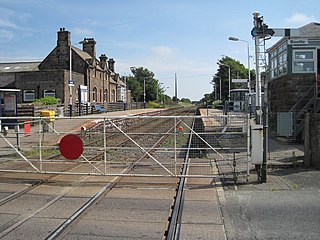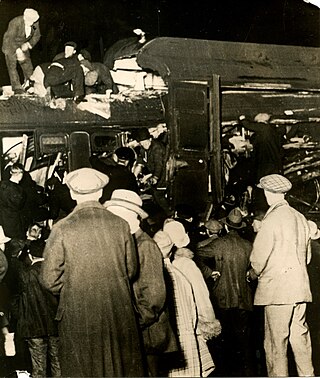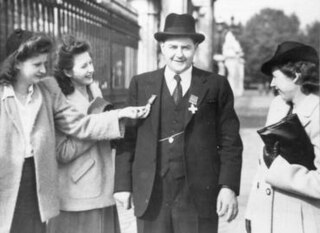
The London and North Eastern Railway (LNER) was the second largest of the "Big Four" railway companies created by the Railways Act 1921 in Britain. It operated from 1 January 1923 until nationalisation on 1 January 1948. At that time, it was divided into the new British Railways' Eastern Region, North Eastern Region, and partially the Scottish Region.

Soham is a town and civil parish in the district of East Cambridgeshire, in Cambridgeshire, England, just off the A142 between Ely and Newmarket. Its population was 12,336 at the 2021 census.

The Abergele rail disaster took place near Abergele, North Wales, in August 1868. At the time, it was the worst railway disaster to have occurred in Great Britain.
Leeudoringstad is a small farming town situated on the main Cape Town - Johannesburg railway line in North West Province of South Africa.

The War Department (WD) "Austerity" 2-8-0 is a type of heavy freight steam locomotive that was introduced in 1943 for war service. A total of 935 were built, making this one of the most-produced classes of British steam locomotive. They were nicknamed Ozzies by the railwaymen.
The Charfield railway disaster was a fatal train crash which occurred on 13 October 1928 in the village of Charfield in the English county of Gloucestershire. The London, Midland and Scottish Railway (LMS) Leeds to Bristol night mail train failed to stop at the signals protecting the down refuge siding at Charfield railway station. The weather was misty, but there was not a sufficiently thick fog for the signalman at Charfield to employ fog signalmen. A freight train was in the process of being shunted from the down main line to the siding, and another train of empty goods wagons was passing through the station from the Bristol (up) direction.

The Ipswich–Ely line is a railway line linking East Anglia to the English Midlands via Ely. There is also a branch line to Cambridge. Passenger services are operated by Greater Anglia. It is a part of Network Rail Strategic Route 5, SRS 05.07, 05.08 and part of SRS 07.03. The line has previously been part of the Great Eastern Main Line.

Bootle is a railway station on the Cumbrian Coast line, which runs between Carlisle and Barrow-in-Furness. The station, situated 24 miles (39 km) north-west of Barrow-in-Furness, serves the village of Bootle in Cumbria. It is owned by Network Rail and managed by Northern Trains.

John Axon GC was an English train driver from Stockport who died while trying to stop a runaway freight train on a 1 in 58 gradient at Chapel-en-le-Frith in Derbyshire after a brake failure. The train consisted of an ex-LMS Stanier Class 8F 2-8-0 No. 48188 hauling 33 wagons and a brake van.

Over the latter years of the 19th and early years of the 20th centuries, Penistone in Yorkshire gained a name as an accident black-spot on Britain's railway network; indeed, it could be said to hold the title of the worst accident black-spot in the country. The main line through the town was the Woodhead route of the Manchester, Sheffield and Lincolnshire Railway between Sheffield Victoria and Manchester, London Road. The line was heavily graded with a summit some 400 yards inside the eastern portal of the Woodhead tunnel.

The Ais Gill rail accident occurred on the Settle–Carlisle line in Northwest England on 2 September 1913. Two long trains were both ascending a steep gradient with some difficulty, because their engines generated barely enough power to carry the load. When the first train stopped to build up steam pressure, the driver and fireman of the second train were distracted by maintenance routines, and failed to observe the warning signals. The collision wrecked several carriages, which were then engulfed by flammable gas, killing 16 people and injuring 38.

The Neishapur train disaster was a large explosion in the village of Khayyam near Nishapur in Iran, on 18 February 2004. Nearly 300 people were killed and the entire village was destroyed when runaway train wagons crashed into the community in the middle of the night and exploded, resulting in Iran's deadliest rail disaster. It is still unexplained how the parked train had come loose and was able to travel such a long distance with no driver or guard.

The Darlington rail accident occurred on the evening of 27 June 1928 when a parcels train and an excursion train collided head on at Darlington Bank Top railway station in County Durham, England. The accident was caused by the parcels train driver passing a signal at danger, due to misunderstanding the signalling layout in an unfamiliar part of the station. This accident resulted in the deaths of 25 people and the serious injury of 45 people.

Benjamin Gimbert, GC was a British engine driver with the London and North Eastern Railway and a recipient of both the George Cross and the Order of Industrial Heroism. Alongside fireman James Nightall, Gimbert was recognised for saving an ammunition train from a fire on 2 June 1944 during the Soham rail disaster.
Railwayman James William Nightall was posthumously awarded the George Cross and the Order of Industrial Heroism for the gallantry he showed during the Soham rail disaster. Nightall was a London & North Eastern Railway (LNER) fireman on a 51-wagon ammunition train driven by Benjamin Gimbert. When a wagon caught fire, Nightall helped Gimbert uncouple it from the rest of the train in order to allow Gimbert to tow the burning wagon away from the rest of the ammunition wagons on the train. The wagon exploded after being towed a distance of 140 yards (130 m), killing Nightall instantly, but preventing a chain reaction in the other wagons. The explosion blew a twenty-foot crater in the track, destroyed Soham railway station, and damaged 600 buildings in the village. Gimbert, who survived the conflagration, was also awarded the George Cross and Order of Industrial Heroism.

Soham railway station is a station on the Ipswich–Ely line, serving the town of Soham in Cambridgeshire. The original station operated between 1879 and 1965. It was reopened in 2021.
The accident at St Bedes Junction was one of several serious accidents in 1915. It featured a double collision and fire fuelled by gas, characteristics shared by a much worse accident that year at Quintinshill. There were also similarities in that a signalman was unaware of the presence of a train near his signal box and rules were not observed. The accident is sometimes referred to as the Jarrow railway disaster as there was no station at Bede and Jarrow was then the nearest place of importance.
The Kirtlebridge rail crash took place in 1872 at Kirtlebridge railway station in Dumfriesshire. An express passenger train ran into a goods train that was shunting; 11 people lost their lives immediately, and one further person succumbed later. The cause was a failure to communicate between the station master in charge of the shunting operation, and the signalman. There was not full interlocking of the points, and the block system of signalling was not in use.
There have been a number of train accidents on the South Australian railway network. The first known incident in this list occurred in 1873 in Smithfield.
The Welwyn Tunnel rail crash took place in Welwyn North Tunnel, north of Welwyn station on the Great Northern Railway, on 9 June 1866. According to L T C Rolt, "from the point of view of damage to engines and rolling stock it was one of the most destructive in railway history."














